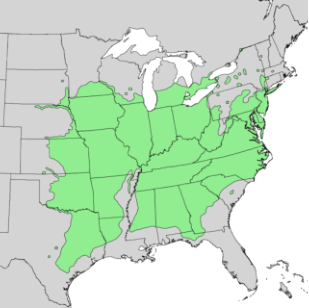





Black walnut. Juglans nigra.
Nutritional value per 100 grams
Energy
2,586 kJ (618 kcal)
Carbohydrates
9.91 g
Starch
0.24 g
Sugars
1.10 g
Dietary fiber
6.8 g
Fat
59.00 g
Saturated
3.368 g
Monounsaturated
15.004 g
Polyunsaturated
35.077 g
omega-3
2.006 g
omega-6
33.072 g
Protein
24.06 g
Vitamins
Vitamin A equiv.
2 μg
(0%)
Vitamin A
40 IU
Thiamine (B1)
0.057 mg
(5%)
Riboflavin (B2)
0.130 mg
(11%)
Niacin (B3)
0.470 mg
(3%)
Pantothenic acid (B5)
1.660 mg
(33%)
Vitamin B6
0.583 mg
(45%)
Folate (B9)
31 μg
(8%)
Vitamin B12
0 μg
(0%)
Vitamin C
1.7 mg
(2%)
Vitamin D
0 μg
(0%)
Vitamin D
0 IU
(0%)
Vitamin E
1.80 mg
(12%)
Vitamin K
2.7 μg
(3%)
Trace metals
Calcium
61 mg
(6%)
Iron
3.12 mg
(24%)
Magnesium
201 mg
(57%)
Manganese
3.896 mg
(186%)
Phosphorus
513 mg
(73%)
Potassium
523 mg
(11%)
Sodium
2 mg
(0%)
Zinc
3.37 mg
(35%)
Other constituents
Water
4.56 g
Units
μg = micrograms • mg = milligrams
IU = International units
Percentages are roughly approximated using US recommendations for adults.
Source: USDA Nutrient Database
Wood.
Black walnut is highly prized for its dark-colored, true heartwood. It is heavy and strong, yet easily split and worked. Walnut wood has
historically been used for gunstocks, furniture, flooring, paddles, coffins, and a variety of other wood products. Due to its value, forestry
officials often are called on to track down walnut poachers; in 2004, DNA testing was used to solve one such poaching case, involving a
55-foot (16-m) tree worth US$2,500. Black walnut has a density of 660kg per cubic meter (41.2 lb/cubic foot), which makes it less dense
than oak.
Pests.
Maggots (larvae of Rhagoletis completa and Rhagoletis suavis) in the husk are common, though more a nuisance than a serious problem
for amateurs, who may simply remove the affected husk as soon as infestation is noticed. The maggots develop entirely within the husk,
thus the quality of the nutmeat is not affected. However, infestations of maggots are undesirable because they make the husk difficult to
remove and are unsightly. Maggots can be serious for commercial walnut growers, who tend to use chemical treatments to prevent
damage to the crop. Some organic controls also exist, such as removing and disposing of infested nuts.
The walnut curculio (Conotrachelus retentus) grows to 5mm long as an adult. The adult sucks plant juices through a snout. The eggs are
laid in fruits in the spring and summer. Many nuts are lost due to damage from the larvae, which burrow through the nut shell. Codling
moth (Cydia pomonella) larvae eat walnut kernels, as well as apple and pear seeds.
A disease complex known as thousand cankers disease has been threatening black walnut in several western states. This disease has
recently been discovered in Tennessee, and could potentially have devastating effects on the species in the eastern United States.
Vectored by the walnut twig beetle (Pityophthorus juglandis), Geosmithia morbida spreads into the wood around the galleries carved by
the small beetles. The fungus causes cankers that inhibit the movement of nutrients in black walnut, leading to crown and branch
dieback, and ultimately death.
Toxicity.
The roots, nut husks, and leaves secrete a substance into the soil called juglone that is a respiratory inhibitor to some plants. A number of
other plants including apples, tomatoes, and white birch are poisoned by juglone, and should not be planted in proximity to a black
walnut. Horses are susceptible to laminitis from exposure to black walnut wood in bedding.
Alternative medicine.
Black walnut has been promoted as a potential cancer cure, on the basis it kills a "parasite" responsible for the disease. However,
according to the American Cancer Society, "available scientific evidence does not support claims that that hulls from black walnuts
remove parasites from the intestinal tract or that they are effective in treating cancer or any other disease".
Big tree.
The largest known living black walnut tree is on Sauvie Island, Oregon. The national champion black walnut is on a residential property in
Sauvie Island, Oregon. It is 8 ft 7 in (2.62m) diameter at breast height and 112ft (34m) tall, with a crown spread of 144 feet (44m).
The largest black walnut in Europe is located in the Castle Park in the city of Sered, Slovakia. It has a circumference of 6.30 meters, height
of 25 meters and estimated age of 300 years.
Source: http://en.wikipedia.org/
Juglans nigra EN

Elbert Little, of the U.S. Department of Agriculture, Forest Service,
and others - USGS Geosciences and Environmental Change Science Center:
Digital Representations of Tree Species Range Maps from
"Atlas of United States Trees" by Elbert L. Little, Jr.

A picture of a nut of the Black Walnuten (Juglans nigra en ) tree.
Photo taken at the Chanticleer Garden where it was identified.
The tree was located near the Teacup Garden.






